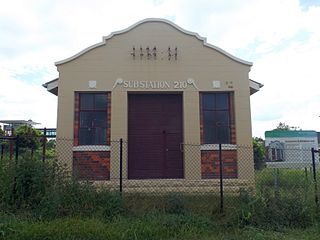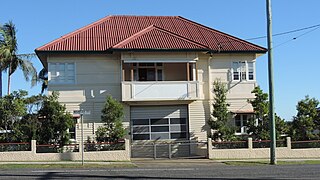
Brisbane Powerhouse is an arts and cultural hub located in a former power station in the Brisbane suburb of New Farm, Queensland, Australia. The venue offers an array of performing arts, visual arts, festivals, and free community events.

Woolloongabba is a suburb of Brisbane, Australia. It is located 2 kilometres (1.2 mi) south-east of the CBD, and contains the Brisbane Cricket Ground and the Princess Alexandra Hospital. It is crossed by several major roads including the Pacific Motorway. The suburb was once home to a large tram depot.

Paddington is an inner suburb of Brisbane, Australia located 2 kilometres (1.2 mi) west of the Brisbane CBD. As is common with other suburbs in the area, Paddington is located on a number of steep ridges and hills. It was settled in the 1860s. Many original and distinctive Queenslander homes can be found in the suburb. Houses are frequently built on stumps, owing to the steep nature of their blocks. Between 2005 and 2010, the median house price has risen over 50% to $1,000,000.

The Brisbane tramway network served the city of Brisbane, Australia, between 1885 and 1969. It ran on standard gauge track. The electric system was originally energised to 500 volts, and subsequently increased to 600 volts. All tramcars built in Brisbane up to 1938 had an open design. This proved so popular, especially on hot summer nights, that the trams were used as fundraisers and often chartered right up until the last service by social groups.

Ipswich Road is one Brisbane's main roads connecting Brisbane to the nearby city of Ipswich, via the Ipswich Motorway. Ipswich Road used to be part of the Cunningham Highway. Logan Road, Pacific Motorway, and Beaudesert Road are the other major roads in the south of Brisbane. The road was an important transport route in 19th century Brisbane.

Queensland, Australia's second largest state in terms of physical area, achieved the early leaders' dream of providing electricity to every home entailing a considerable degree of pioneering, innovation, and commitment. Queensland proved to be a pioneer in the supply of electricity in Australia, with the first public demonstration in Australia, the first recorded use for public purposes in the country, the first Parliament House in Australia and the first commercial operations in Australia all occurring in Brisbane.

Windsor Town Quarry Park and Tramways Substation No. 6 is a heritage-listed former quarry with electrical substation at 356 Lutwyche Road, Windsor in the City of Brisbane, Queensland, Australia. It was built from c. 1926 to c. 1928. The park and substation were added to the Queensland Heritage Register on 31 May 2005. There is another, larger substation building, Tramways Substation No. 13 which was designed by Frank Gibson Costello and became operational in June 1949.

Brisbane City Council Tramways Substation No. 8 is a heritage-listed electrical substation at 134 Kedron Park Road, Wooloowin, City of Brisbane, Queensland, Australia. It was built from 1934 to 1937. It was added to the Queensland Heritage Register on 5 August 2003.

Coorparoo Substation No. 210 is a heritage-listed electrical substation at 12 Main Avenue, Coorparoo, City of Brisbane, Queensland, Australia. It was designed by Reyburn Jameson and built in 1930 by A. Mason. It is also known as Substation 10. It was added to the Queensland Heritage Register on 1 August 2005.

Old Cleveland Road Tramway Tracks is a heritage-listed tramway at Old Cleveland Road, Carina, City of Brisbane, Queensland, Australia. It was built in 1948 by Brisbane City Council. It is also known as Belmont Electric Tramway. It was added to the Queensland Heritage Register on 24 March 2000.

Wynnum Fire Station is a heritage-listed former fire station at 39 Mountjoy Terrace, Wynnum, City of Brisbane, Queensland, Australia. It was designed by Atkinson & Conrad and built from 1922 to 1938. It was added to the Queensland Heritage Register on 28 May 1999.

Victoria Park is a heritage-listed park at 454 Gregory Terrace, Spring Hill & Herston, City of Brisbane, Queensland, Australia. It was added to the Queensland Heritage Register on 3 December 2007.

Paddington Tramways Substation is a heritage-listed former electrical substation at 150 Enoggera Terrace, Paddington, City of Brisbane, Queensland, Australia. It was designed by Roy Rusden Ogg and built from 1929 to 1930. It was added to the Queensland Heritage Register on 22 March 1993.
The electricity supply in Brisbane has been an important part of the economic and social development of the city of Brisbane, Queensland, Australia.
A network of Brisbane tramways substations, supplied from the Brisbane Powerhouse, were developed by Brisbane City Council after they took over the Brisbane Tramways system from Brisbane Tramways Company (BTCo). The new powerhouse and substations were needed, as BTCo had not adequately invested enough into the electricity network to keep the system running efficiently. Brisbane City Council maintained this electricity network from 1927 until 1969, when the decision was made not to have Trams in Brisbane, and the network was shut down and decommissioned.

Electricity Substation No. 269 is a heritage-listed electrical substation located at 36 Anglesea Street, Bondi, Waverley Municipality, New South Wales, Australia. It was designed by Walter Frederick White, City Architect's Office and Municipal Council of Sydney and built in 1928 by the Municipal Council of Sydney. It is also known as #269 'WAVERLEY' 33KV ZONE, ELECTRICITY DEPT SUBSTATION No. 269, Angelsea Sub Station and Waverley Zone Substation. The property is owned by Ausgrid, an agency of the Government of New South Wales. It was added to the New South Wales State Heritage Register on 2 May 2008.

The Electricity Substation No. 349 is a heritage-listed electrical substation at 2S Frances Street, Randwick, City of Randwick, New South Wales, Australia. It was designed by Walter Frederick White, City Architect's Department and Municipal Council of Sydney and built during 1930 by J Rutherford. It is also known as #349 Princes Street substation. The property is owned by Ausgrid, an agency of the Government of New South Wales. It was added to the New South Wales State Heritage Register on 2 May 2008.

Taylor Square Substation No.6 and Underground Conveniences is a heritage-listed electrical substation and underground public toilets at the intersection of Taylor Square, Oxford, Forbes and Bourke Streets, in the inner city Sydney suburb of Darlinghurst in the City of Sydney local government area of New South Wales, Australia. Both the substation and the underground conveniences were designed by Robert Hargreave Brodrick and built from 1904 to 1907, with Owen Ridge & Sons building the substation and G. D. Getherson the underground public conveniences. The property is owned by City of Sydney. It was added to the New South Wales State Heritage Register on 2 July 2004.





























